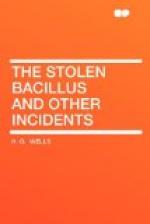The doctor was a blockhead, a half-qualified general practitioner, and quite ignorant of mental science. He simply said there was no moth. Had he possessed the wit, he might still, perhaps, have saved Hapley from his fate by entering into his delusion and covering his face with gauze, as he prayed might be done. But, as I say, the doctor was a blockhead, and until the leg was healed Hapley was kept tied to his bed, and with the imaginary moth crawling over him. It never left him while he was awake and it grew to a monster in his dreams. While he was awake he longed for sleep, and from sleep he awoke screaming.
So now Hapley is spending the remainder of his days in a padded room, worried by a moth that no one else can see. The asylum doctor calls it hallucination; but Hapley, when he is in his easier mood, and can talk, says it is the ghost of Pawkins, and consequently a unique specimen and well worth the trouble of catching.
THE TREASURE IN THE FOREST
The canoe was now approaching the land. The bay opened out, and a gap in the white surf of the reef marked where the little river ran out to the sea; the thicker and deeper green of the virgin forest showed its course down the distant hill slope. The forest here came close to the beach. Far beyond, dim and almost cloudlike in texture, rose the mountains, like suddenly frozen waves. The sea was still save for an almost imperceptible swell. The sky blazed.
The man with the carved paddle stopped. “It should be somewhere here,” he said. He shipped the paddle and held his arms out straight before him.
The other man had been in the fore part of the canoe, closely scrutinising the land. He had a sheet of yellow paper on his knee.
“Come and look at this, Evans,” he said.
Both men spoke in low tones, and their lips were hard and dry.
The man called Evans came swaying along the canoe until he could look over his companion’s shoulder.
The paper had the appearance of a rough map. By much folding it was creased and worn to the pitch of separation, and the second man held the discoloured fragments together where they had parted. On it one could dimly make out, in almost obliterated pencil, the outline of the bay.
“Here,” said Evans, “is the reef and here is the gap.” He ran his thumb-nail over the chart.
“This curved and twisting line is the river—I could do with a drink now!—and this star is the place.”
“You see this dotted line,” said the man with the map; “it is a straight line, and runs from the opening of the reef to a clump of palm-trees. The star comes just where it cuts the river. We must mark the place as we go into the lagoon.”
“It’s queer,” said Evans, after a pause, “what these little marks down here are for. It looks like the plan of a house or something; but what all these little dashes, pointing this way and that, may mean I can’t get a notion. And what’s the writing?”




